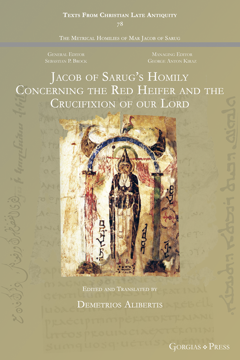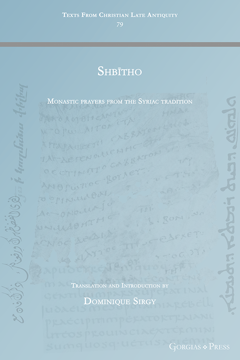Jacob of Sarug's Homily Concerning the Red Heifer and the Crucifixion of our Lord
Edited and Translated by Demetrios Alibertis
Series: Texts from Christian Late Antiquity 78
ISBN: 978-1-4632-4471-2
Jacob of Sarug's homily on the red heifer slaughter ritual in Numbers 19. For Jacob, the narrative is a prefigurement of Christ's death and its ability to restore and permanently purify all who enter the church through baptism.
$28.00 (USD) $16.80 (USD)
Shiʿite Rulers, Sunni Rivals, and Christians in Between
Muslim-Christian Relations in Fāṭimid Palestine and Egypt
By Steven Gertz
Series: Islamic History and Thought 32
ISBN: 978-1-4632-4473-6
A historical study of the Fāṭimid caliphate in Palestine and Egypt during the fourth/tenth and fifth/eleventh centuries.
$95.00 (USD) $57.00 (USD)
Shbītho
Monastic prayers from the Syriac tradition
Translation and Introduction by Dominique Sirgy
Series: Texts from Christian Late Antiquity 79
ISBN: 978-1-4632-4475-0
The Shbītho d-Dayroye is a thirteenth-century anthology dedicated to the personal prayer of monks and nuns. The collection comprises the writings of great saints in the Syriac Orthodox tradition including Ephrem the Syrian, Abraham Qidun, John Chrysostom, Gregory of Nazianzus, Philoxenos, Basil the Great, and Isaac the Syrian. For each of the seven daily prayer times (morning, third hour, noon, ninth hour, evening, and night), there is a main prayer and a closing prayer. The present edition is the first translation to make the spiritual treasures of the original Syriac text available to readers in English.
$45.00 (USD) $27.00 (USD)
The New Testament in Syriac. Peshitta Version
Paul
ISBN: 978-1-4632-4479-8
More than one hundred years after the publication of the BFBS volume of the Peshitta NT (1920), a critical edition of the Praxapostolos is still a desideratum. This edition fills the gap for the Corpus Paulinum. It expands the collations of the Scottish scholar John Pinkerton (1882–1916) up to some 60 manuscripts, incl. 5 lectionaries and 7 ‘masoretic’ manuscripts; it is based on the (slightly modified) BFBS text, which was established by the majority vote of Pinkerton’s collated manuscripts. The present edition turns the editorial principle of ‘majority vote’ into a textual history, considering the East-West-bifurcation of textual traditions, and the development of the Textus receptus by standardization. 9 printed editions are included, among which are 6 of the Textus receptus (incl. the editio princeps of 1555), thus covering the transmission of the Corpus Paulinum from the beginnings up to the 16th century.
$156.00 (USD) $93.60 (USD)
Journal of Language Relationship 20/1-2
Editor-in-Chief Vladimir Dybo; Managing Editor George Starostin; Editorial Secretary Tatiana Mikhailova; Editorial Board Anna Dybo, Manuel Molina, M. N. Saenko & Ilya Yakubovich
Series: Journal of Language Relationship 20/1-2
ISBN: 978-1-4632-4481-1
The Journal of Language Relationship is an international periodical publication devoted to the issues of comparative linguistics and the history of the human language. The Journal contains articles written in English and Russian, as well as scientific reviews, discussions and reports from international linguistic conferences and seminars.
$74.00 (USD)
The Martyrdom of Mar Grigor Piran-Gušnasp and The Martyrdom of Mar Yazd-panah
Translation and Introduction by Florence Jullien; In Collaboration With Adam H. Becker
ISBN: 978-1-4632-4487-3
In the mid-6th century, Grigor, the general of the Sasanian king’s armies and a converted from Zoroastrianism to Christianity, was put to death. This event brings about the conversion of several Zoroastrian notables such as Yazd-panāh, a judge who also died as a martyr three years later, and the courtier ʿAwira. The reign of King Khusrō I (531–579) was a key-chapter in the history of the Persian Empire, but also for the Church of the East, some members of which were involved in the Sasanian administration. These East-Syrian historical texts, which are among the few passions of this period in Syriac, have received little scholarly attention. This volume offers a critical text and commentary, as well as the first translation into English of these two martyr texts. Written by contemporaries, they provide valuable information regarding socio-religious life and the political context. They demonstrate how Persian Christians, despite sporadic persecution, were able to maintain a distinct identity while simultaneously acculturating to the norms of Iranian society.
$75.00 (USD) $45.00 (USD)





